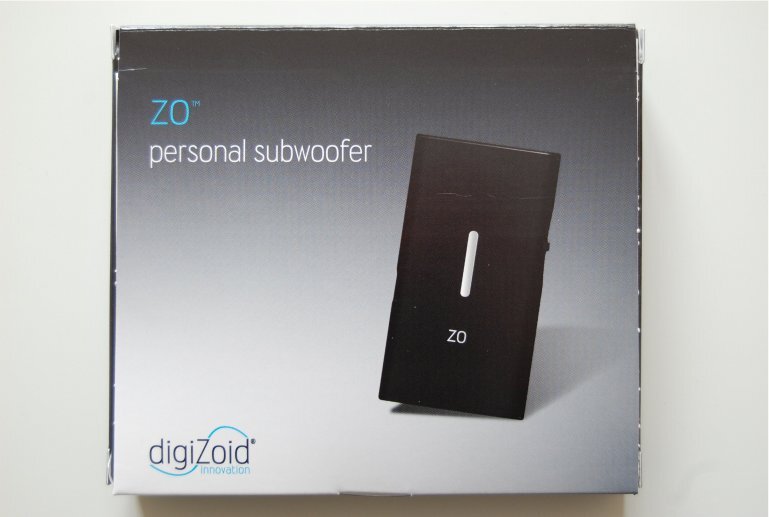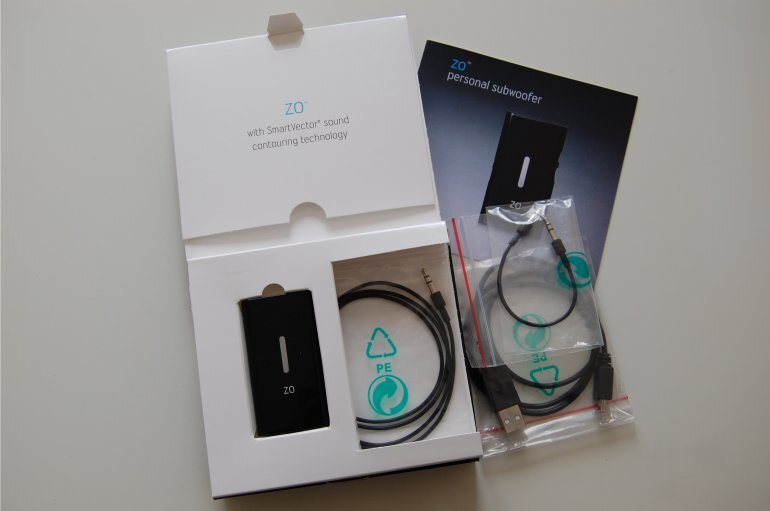At the beginning of May digiZoid introduced the Zo personal subwoofer, which claimed to enhance a listener's sonic experience by offering increasing degrees of bass contouring to any audio fed through it. Over the past week I've had the chance to take the Zo for a spin. Has it lived up to the claims of its manufacturer? Read on for a full review.
The Zo Personal Subwoofer from digiZoid is a portable audio enhancement device which sits between an audio player and speakers or headphones. Rather than merely amplifying output volume, the Zo offers 32 incremental bass intensity profiles which is said provide the kind of listening experience familiar to those who use a home theater system.

.
Over the past few days I have had the opportunity to give the Zo a thorough testing with as many different players as I could find. To introduce a degree of fairness I have used the same five music tracks in both MP3 and CD format and the same movie. The film in question is the iconic "Blues Brothers" from 1980, featuring lots of excellent musical moments from the likes of Ray Charles, James Brown, John Lee Hooker and of course the Brothers themselves.
Choosing music tracks was a more difficult task. Although my tastes are varied, I'm not a fan of pop music as such, so the chosen tracks are as follows:
- "Money" from Pink Floyd's "Dark Side of the Moon" - bit rate of 320kbps and audio sample rate of 44kHz - an audiophile favorite which offers a rich and varied soundscape and a damn fine bass line to boot
- "The Ballad of John Henry" from the album of the same name by Joe Bonamassa - bit rate of 256kbps and audio sample rate of 44kHz - a complex blues exploration by one the genre's brightest stars
- "Precious and Grace" by Queens of the Stone Age with Billy Gibbons from "Lullabies to Paralyze" - bit rate of 128kbps and audio sample rate of 44kHz - chosen because as well as a thundering bass there are numerous guitars in there too, I was interested to see how the Zo handled this
- "Forest Gardens" from "State of Nature" by Stanley Jordan - bit rate of 256kbps and audio sample rate of 44kHz - there's quite a lot going on here, again I was interested in seeing how the Zo dealt with such complexity.
- "Coke" by The Drum from the album "Diskin" - bit rate of 128kbps and audio sample rate of 44kHz - another experiment in diversity.
The Unboxing

The Zo's cardboard container sports the words "Blow your mind, not your ears" on the front and contains the device itself, two 3.5mm audio cables (one short, one long), a USB charging cable and a smart start instruction manual. The Zo personal subwoofer is very light at just over an ounce and it's 1.5- x 0.38- x 2.75-inch dimensions won't take up too much room in a pocket or on a desk.
The device has a quality build feel to it, the LightScale contour level indicator on the front is mirror-like, there is a USB charging port to the left, audio input and output to the top and a SmartVector controller to the right. To charge the Zo's battery, the device needs to be connected to a spare USB port on a computer or laptop for around two hours.
For its first test run I opted to try it with my laptop. I have an Altec Lansing subwoofer set up on my PC so I decided to see how the Zo compared with that. The SmartVector controller on the side of the unit is used to switch on the device and scroll through the 32 subwoofer contour profiles. When it's switched off the circuitry allows the unaltered audio signal through to whatever listening apparatus is chosen - in this case, speakers.
First Switch On
When I switched on the Zo for the first time, the LightScale display lit up orange which indicated that the contour level was set to one of the mid-range profiles. I decreased the contour level to the lowest setting of green. The manufacturer recommends that before using the Zo, the audio source is neutralized and the source volume turned down to about 25 percent. Not following the last part could result in quite a surprise, as it did for me. The amplification was enormous for such a small device.
At its lowest green level, it's obvious that the Zo's contouring has kicked in although it seems to be acting more as a source audio boost than a subwoofer. Moving up through the contour profiles subtly increases the level of bass and by the time I was leaving the green zone towards orange the difference between naked desktop subwoofer setup and Zo was negligible. Heading up past orange towards the red and the bass began to sing. I have to say that the red zone proved too bass heavy for my taste though.
digiZoid claims that its SmartVector sound contouring system enhances the audio without causing annoying distortion, and signal clarity certainly was impressive. Even in the bass heavy red zone, the mids and highs were crisp and clear. When I moved my listening experience to a pair of Sennheiser headphones I had to turn down the volume of the audio source yet again.

After running through numerous plays of the MP3s and then CD with both speakers and headphones I loaded the DVD into the optical drive bay and sat back. Again, having to turn down source volume was the first thing I noticed. Although there were subtle differences to the delivery of dialog and action sequences, it was when the music started that the Zo's effects were most noticeable.
digiZoid recommends using the signal bypass function (switching off the Zo) to "obtain a full appreciation of Zo's sound enhancement capabilities." This inevitably leads to a lot of volume tweaking but the differences are nonetheless quite arresting. I did find that re-enabling the Zo cut the volume for a short time while the system kicked in, but pausing the source, enabling the Zo and then re-starting the audio overcame this minor issue.
Moving On
As I went on to test the Zo on both expensive and inexpensive MP3 players, hi-fi systems and televisions the results were similarly positive. Not everything in this soundgarden was rosy though. Having found that different portable situations called for different contour profiles to be engaged, the fact that the Zo only remembered the last setting led to a few more contour searches than I would have liked. As well as the facility to store a few favorite profiles for easy recall, some sort of numerical indication of profile intensity in addition to the color coding would also have been welcome.
I also found the battery charging via USB to be a little restrictive and the apparent lack of battery level indicator did lead to the odd occasion where the device simply cut out without warning. Aside from such minor irritations, the painfully easy to use device significantly improved the listening enjoyment through every audio source I tried, except one. I connected the Zo to the headphone jack of my Marshall guitar amplifier and noticed significant problems.
This is obviously an area for which the Zo was clearly not designed but I was curious as to what contouring would achieve in such a situation. As it was, the intentional signal distortion proved just too much for the personal subwoofer and although it fared slightly better with my HoneyTone personal guitar amplifier, any thoughts of playing with the EQ via the Zo were quickly abandoned and the unit returned to the audio equipment it was created to be used with.
Overall though, and no doubt a testament to how beneficial I found it to be, digiZoid's personal subwoofer was in use more than it wasn't. Over the years I have tried out an awful lot of earphones, headphones, speakers and audio amplifiers. Only the delights of a quite expensive, and much less portable, 5.1 surround sound system has come even close to the subtle but immediately noticeable bass contour changes and electronic signal enrichment offered by the Zo. It's a marvelous piece of kit and a very useful addition to a mobile audio arsenal.
As a bonus, it also extended the battery life of tested portable players as it allowed me to significantly turn down source volume levels.











